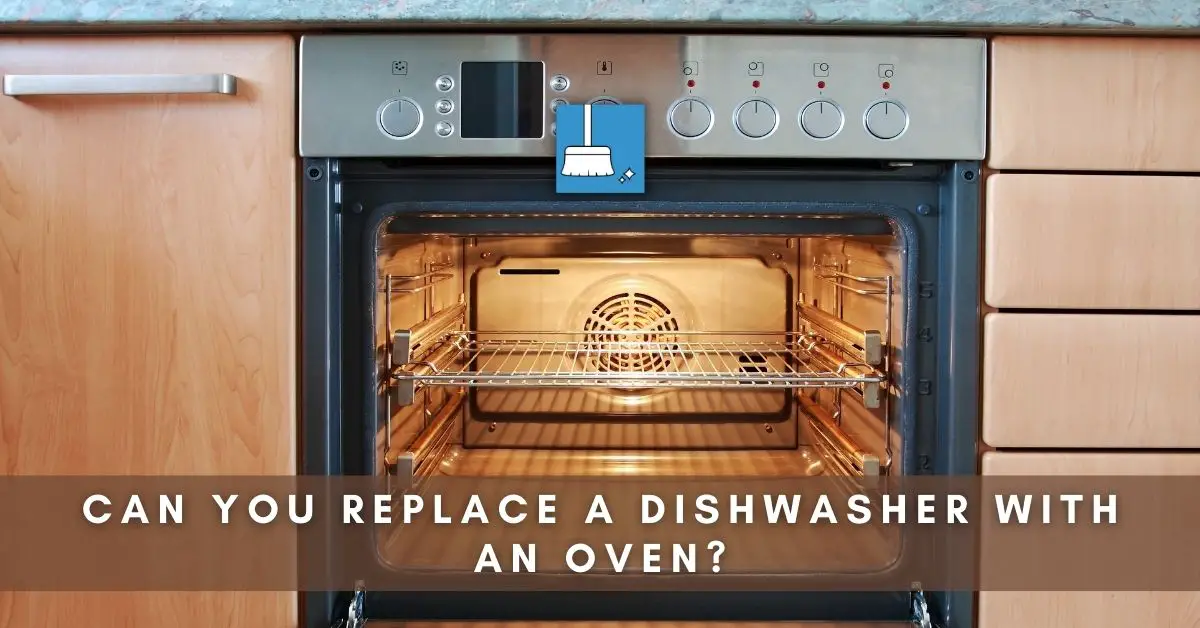Ovens and dishwashers are necessary kitchen appliances. You may want to remodel your kitchen and install an oven where the dishwasher was or the other way round.
Read on to find out more about switching the places of these appliances and the requirements needed for installing an oven and a dishwasher.
Can You Replace a Dishwasher with an Oven?
A dishwasher can be replaced with an oven but you will need to consider the circuit and gas supply requirements of both these appliances.
If you are thinking of changing the places of your kitchen appliances, there are some important points that you need to keep in mind.
There are different types of ovens. An electric oven will need its own dedicated circuit. A dishwasher also uses its own dedicated circuit. Gas ovens need a gas supply pipe, so you need to check whether your house has one already.
Swapping places of regularly used appliances should only be done if it is practical. Do not interfere too much with the electric wiring. Certain appliances should not be placed together.
Ovens can be categorized into two: wall ovens and stand-alone ovens.
Wall oven: This is built into the kitchen’s cabinetry, providing a seamless look for your kitchen. Wall ovens are smaller than stand-alone ovens. They however do not include a stovetop.
Stand-alone oven: This is the freestanding traditional oven, which includes the stove on top. Stand-alone ovens are usually larger than wall ovens.
How Do You Install an Oven? (In Place of a Dishwasher)
Certain requirements must be met before installing a new oven:
1- The cabinets should be able to withstand temperatures of up to 90⁰C.
2- There should be ventilation holes in the cabinets for built-in ovens, to ensure free flow of air.
3- There must be a dedicated gas line or an electricity supply line nearby. The National Electric Code requires 240-volt current and two-pole circuit breakers.
If you are thinking of redesigning your kitchen, you may want to move appliances around to suit your convenience.
Let’s say you want to install the oven where your dishwasher was. We will look at two scenarios:
A. The Dishwasher Is near the Sink
You can remove the dishwasher which is near the sink and install a new oven in its place. Kitchen sinks are normally surrounded by cabinetry so the oven would be placed inside a cabinet.
Before removing the dishwasher:
1- Disconnect the power and water supply.
2- Disconnect the supply hose from the shut-off valve in the water supply pipe.
3- Disconnect the drain hose from the sink drain.
4- Locate the wires in the junction box in the dishwasher. Open it and wire caps for both the black and white wires. Detach the ground wire by unscrewing it from the inlet in the junction box.
5- The dishwasher is held in place in the cabinet by mounting brackets, which will need to be unscrewed.
Carefully slide out the dishwasher.
Steps to Install an Electric Oven
STEP 1: Adjust the cabinet size
Dishwashers are generally 24″ wide. Ovens are wider, starting from 30″ and going up to 48″.
The existing cabinets may have to be adjusted to accommodate the oven, depending on the size. It is easier to adjust an ‘end cabinet’. Leave a small gap of 1/4″ on each side.
STEP 2: Turn off the power supply
Before installation, the switch supplying power to the oven should be turned off from the fuse box. Lock the fuse box, if possible, to ensure nobody switches it back on during installation. Test with a voltage tested to ensure that power is off.
STEP 3: Connect the cable to the oven
Unscrew the cover for the terminal box of the oven. The terminal box is located at the back of the oven.
Use wire connectors to connect the wires from the oven to the oven’s cable. Consult the installation manual for more details about the colors of the wire.
Note: A dishwasher has its dedicated circuit of 120/125volt, with a 15-amp circuit. The circuit is supplied with a 14/2 NM (Non-metallic) wire with ground. Electric ovens can use either 120v or 240v and between 20 – 60 amps of current. The oven will need its dedicated circuit. The instruction manual will specify the power requirements for your oven.
You may need an electrician to adjust the electric requirements for the oven:
- To install the control unit near the oven
- To install a double pole isolating switch to connect the oven’s control unit to the power supply of the house
Close the terminal box and tighten the screws tightly.
STEP 4: Connect the cable to the control unit: Ensure the control unit is free from the power supply by testing it with a voltage tester. Push the wires in the correct slot in the control unit. Do not cross-thread the screws.
STEP 5: Place the oven in the cabinet carefully. Secure it with screws.
STEP 6: Turn on the power supply.
Always read the instruction manual first and check the electrical codes and related guidelines. Consult an electrician if in doubt.
Steps to Install a Gas Oven
STEP 1: Ensure the gas valve is off. It should be perpendicular to the pipe. Unscrew the plug from the gas pipe.
STEP 2: Apply pipe sealer on the threads of the connector. You can also use special gas tape specifically for gas installations. Tighten the connector to the gas pipe.
STEP 3: Apply pipe sealer to the safety valve and connect it to the connector.
STEP 4: Connect the gas supply hose to the safety valve.
STEP 5: Add a connector to the gas line in the oven. Connect the hose to it.
STEP 6: Turn the gas valve back on.
STEP 7: Check for leaks by applying soapy water to the connections. If there are bubbles, it means that there is a leak
STEP 8: Place the oven in the cabinet and screw it in place.
B. The Dishwasher Is Far from the Sink
This is the second scenario. If you want to place an oven where the dishwasher is far from the sink, you can either go for a stand-alone oven or a wall oven.
Steps to Install a Stand-Alone Oven
STEP 1: Disconnect the power supply and ensure all the knobs of the oven are off as well.
STEP 2: The stand-alone oven should be near a power outlet, specifically of 220volts and connected to the ground.
STEP 3: Freestanding ovens can be placed in between 2 cabinets. Adjust the height of the oven.
STEP 4: If it is being placed in between 2 cabinets, mount the security brackets as per instructions.
STEP 5: Slide the oven into place and ensure the security brackets are in place.
STEP 6: Plug in the oven to the power outlet and reconnect the power supply.
Steps to Install a Wall Oven
i. Disconnect the power supply from the circuit breaker.
ii. Measure and prep the cabinet or unit where the oven will be installed.
iii. Connect the electric wires as stated above for connecting electric ovens. Consult an electrician if necessary to ensure the wiring is done correctly.
iv. Slide the oven and secure it in place.
Like dishwashers, the ovens also require a dedicated circuit. The requirements for these 2 appliances differ, so an electrician must be consulted before installing and connecting electric ovens.
Where Will Your Dishwasher Go Then?
If you remove the dishwasher which was near the sink, you can move it to an area of the kitchen that will have the plumbing and electric requirements needed.
If it is placed near a free-standing oven, there must be a gap of 2″ between them. This is to allow the heat from the oven to dissipate, without damaging the dishwasher.
If you have a utility room with a sink, you can install the dishwasher there, as the plumbing requirements would be met. However, it will be tedious ad risky to carry the cleaned dishes and utensils back to the kitchen.
You can also consider replacing your dishwasher with a portable dishwasher, which can be put away when not in use. It also does not require a dedicated electric circuit and water supply lines.
It is usually connected to the kitchen faucet when in use. This allows you to have space for your oven, and a portable dishwasher can also be used as an extra countertop.
Can You Put an Oven in a Cabinet?
Ovens can be placed in kitchen cabinets. Kitchen cabinets are usually made of wood such as hardwood, or wood-like materials such as MDF, fiberboards, and plywood. Stainless steel and aluminum can also be used to make kitchen cabinets.
When the oven is in use, although the interior can get quite hot, the exterior of the oven will not be excessively hot. You will need to ensure the cabinets and counters that surround the oven can withstand minimal amounts of heat.
NKBA (National Kitchen & Bath Guidelines) states that there should be adequate landing space (15 inches) next to the wall oven, to easily place the hot items just removed from the oven.
You must also ensure that there is a gas line or electrical wiring near the cabinet where the oven will be installed.
Wall ovens will not have a stovetop, so installing a separate stovetop will take up additional space in the kitchen.
Can You Put an Oven Above a Dishwasher?
An oven should not be placed above a dishwasher.
1- Dishwashers emit steam while the cycle is running. This can eventually damage the underside of the oven.
2- It can be risky, as one appliance uses water and the other uses electricity.
3- The cooking can be interrupted when the dishwasher needs to be unloaded.
It is not aesthetically pleasing to the eye. Both appliances are bulky. The oven can be wider than the dishwasher and it will look like an unprofessionally designed kitchen.
Such a set-up will reduce the resale value of the house.
You would rather go for a portable dishwasher if space were an issue.
Final Thoughts!
Using dishwasher space to fit in a wine cooler or an oven or even a washing machine is not something other-worldly.
It is a good idea to hire an electrician to ensure the wiring of ovens and dishwashers is done according to the NEC codes and to ensure the safety of the homeowners.
It is practical to just leave the dishwasher under the sink, and install a wall oven or use a free-standing oven.






Pingback: Can You Install A Washer Instead Of Dishwasher? (DIY Guide!) »